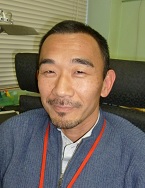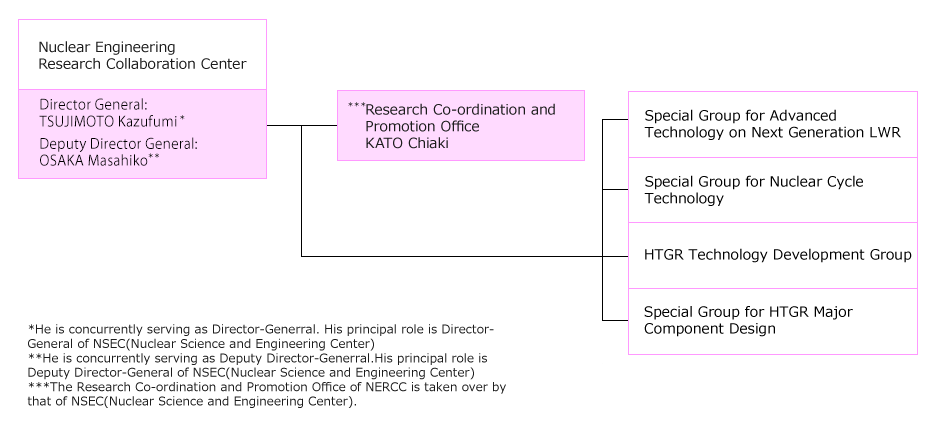

April, 2023

Dr. TSUJIMOTO Kazufumi
Director General
The Nuclear Engineering Research Collaboration Center (NERCC) was launched in January 2006 to provide platform functions for collaborative research with industry and to strengthen collaboration with industry. At this center, research resources such as human resources and basic research facilities and equipment owned by JAEA will be used together with the industry to efficiently promote nuclear research and development based on the needs of society.
A major feature of this system is that researchers from the industry have the same status as JAEA staff within JAEA. In addition, they can use JAEA's infrastructure, facilities and equipment necessary for joint research and development. By doing so, both researchers from the industry and JAEA staff efficiently and smoothly promote research and development on research topics of interest to both the industry and JAEA related to nuclear energy.
The funds required for research activities are assumed to be jointly applied by the industry and JAEA for public research. Alternatively, we are also planning to carry out joint research by private spending.
So far, special groups have been set up in the center in the following fields, and research and development has been completed.
| ✓ | In the field of ultra-sensitive nondestructive detection technology, we developed the method to measure nuclear fuel material using high-energy neutrons, examined the optimal arrangement of detectors, designed a measurement system based on the results, and evaluated its performance. This results has contributed to the development of nuclear security technology. |
| ✓ | In the field of R & D related to interface phenomena under radiation, we developed a method for the rapid quantitative analysis of material surface cracks induced by environmental factors as an evaluation method for aging effects of nuclear equipment. We also acquired and analyzed basic test data required to evaluate the radiation effects on the material surface. As a result, it was confirmed that abnormal acceleration of corrosion and hydrogen gas release at low temperature radiation condition were important in evaluating aging of material surface, and advanced aging effect evaluation technology under radiation. |
| ✓ | In the field of accelerator RI generation technology development, basic test data was acquired and analyzed regarding separation and purification of radioactive isotopes (RI) such as 99Mo used for nuclear medicine by accelerator neutrons. In particular, it was the first in the world to be successful in labeling 99mTc into pharmaceuticals with accelerator neutrons. In this way, we have formed the necessary technical basis for RI production with accelerator neutrons. |
| ✓ | In the field of material melting behavior evaluation, basic knowledge and simulation technology on the behavior of metals in the blast furnace (interaction between molten metal and molten oxide, heat flow and physicochemical reaction from solid to solid-liquid mixed layer, liquid phase etc.) were used to understand the melting phenomena of the reactor core at a severe accident. We have advanced simulation technology that enables us to estimate core melting progress and melting loss at the bottom of the pressure vessel during the severe accident. |
| ✓ | The ultra high purity EHP (Extra High Purity) alloy is one of the leading candidates for the next-generation reprocessing material because it is excellent in nitric acid resistance. In order to put the EHP alloy into practical use, we conducted corrosion resistance tests in high-level simulated waste liquid and under gamma irradiation, and acquired corrosion resistance and mechanical property data of pipes, plates and joint joints. As a result, we are looking into practical use of EHP (Extra High Purity) alloy. |
| ✓ | In the field of graphite and carbon materials, the related material technologies were accumulated aiming for the further application to the HTGR by evaluating the property change of graphite due to neutron irradiation, and the design database of advanced graphite materials as the HTGR components. |
| ✓ | Advanced Technology on Next Generation LWR, |
| ✓ | Nuclear Cycle Technology, |
| ✓ | HTGR Technology Development, |
| ✓ | HTGR Major Component Design, |

The Nuclear Science and Engineering Center (NSEC) homepage clicks here
We are developing advanced technologies such as the improved Monte Carlo reactor design methods and the large scale multi-phase CFD simulation technique as next generation technologies required for improving the safety and economics of LWR systems. These advanced technologies are applied to the improvement of burnup calculation and the improvement of multi-phase model in subchannel analysis codes.
We are developing the method of analyzing the radioactive wastes, including vitrified waste, by identifying the chemical properties and behavior of these wastes. These will improve the basic technology needed to solve the problems arising from the vitrification and reprocessing process and solve the issues in operation or safety assessment of the process.
The objectives of the group are construction of plant concept for a commercial small-sized High-Temperature Gas-cooled Reactor (HTGR) aiming for economic improvement with high inherent safety and high thermal efficiency. We are also examining the sophistication of the HTGR plant concept by applying a gas turbine power generation system and a heat application system such as hydrogen production.
The high temperature gas cooled reactor (HTGR) has excellent inherent safety features and multipurpose heat utilization capabilities. This special group is carrying out research and development of HTGR main component design of 750oC reactor outlet coolant temperature for high temperature steam supply to steam turbine power generation and chemical plant for early development of HTGR.